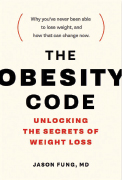BOOKMARK
Title: The Obesity Code: Unlocking the Secrets of Weight Loss
Author: Jason Fung, MD
Publisher: Greystone Books
Date: March 2016
Price: $18.95, paperback; 296 pages

According to data from the National Cancer Institute (NCI), obesity plays a significant role in developing at least 12 different cancers. Moreover, obesity has eclipsed smoking as the nation’s leading cause of preventable disease. In the 1950s, upward of 60% of Americans smoked. The War on Tobacco—arguably the country’s most successful population-based health-care initiative—helped bring that catastrophic number down to the current rate of about 15%. There is no war on obesity, for a number of reasons. For one, obesity is sorely misunderstood.
Jason Fung, MD, is a nephrologist and founder of the Intensive Dietary Management Program. His book, The Obesity Code: Unlocking the Secrets of Weight Loss, sets out a robust theory of obesity that provides insight into the cause of this national health crisis and offers suggestions on how to get it under control.
Complex Issue
Like most experts in obesity, Dr. Fung does not subscribe to the simple weight equation based on calories in vs calories out. “Virtually every person who has used caloric reduction for weight loss has failed…. By every objective measure, this treatment is completely and utterly ineffective. Yet it remains the treatment of choice, defended vigorously by nutritional authorities.”
The book is organized into six sections. The writing is clear and layperson friendly but meaty enough on the science side to satisfy medical professionals. In chapter 1, Dr. Fung describes the evolution of the current obesity epidemic. Those who think that the “epidemic” word is overreach will find the latest data from the Centers for Disease Control and Prevention edifying. About 70% of adult Americans are overweight or obese; 40% are obese; and 8% suffer what’s categorized as extreme obesity, which means they have trouble doing common things such as walking. That translates into 21 million American adults who are literally crippled by excess weight. As pointed out in the book, the downstream consequences to our health-care system are mind-bending.
A History of Misinformation
The author turns back the pages of time to the 1970s, as the nation struggled with the debate over what constituted good health and the government searched for a definition it could promote to the citizenry. It was settled by a governmental committee led by Senator George McGovern. Dietary fat became public enemy number one. This spawned the Dietary Goals for the United States. In effect, the nation would follow the nutritional advice of several politicians. For the first time in our history, the U.S. government intruded into our kitchens.
Next up was the infamous food pyramid, which, as Dr. Fung notes, was influenced by the lobbying power of the food industry. In 1995, the American Heart Association advised that Americans should eat six or more servings of breads, cereals, pasta, fruit punches, and carbonated soft drinks daily. Unfortunately, the food pyramid, still heavily influenced by industry, hasn’t gotten much better.
Nature vs Nurture
After examining the scientific flaws in the simple caloric intake theory, Dr. Fung segues into one of the more interesting chapters in the book, on inherited obesity. Hardliners will think that, for the most part, this concept is passing the buck on personal responsibility. This section might change that mindset.
It’s fairly obvious that obesity runs in families. Childhood obesity is associated with a 400% increased risk of adult obesity. The author digs deep into the nature vs nurture debate. He brings the readers through studies looking at identical twins raised apart that have offered surprising results. Dr. Fung also looks at what’s called the thrifty-gene hypothesis (which assumes that chronic food shortages prevented obesity in the past), trying to draw a metaphor to the present, which doesn’t pan out.
The Obesity Code is not without flaws and some hyperbole, but those are minor gripes. Dr. Fung comes across as a one-doctor army in the war on obesity, our number one health crisis.—
Tweet this quote
The book also delves into another key factor in the obesity epidemic: poverty. Socioeconomic status has long been known to play a role in health-care outcomes, as it does in obesity. Simply put, the states with the most poverty have the highest rates of obesity. There is no one answer to this conundrum. It’s been postulated that the poor have less access to healthful dietary choices. Dr. Fung looks at an interesting theory called the food-reward hypothesis—that the rewarding quality of food causes overeating. The poor derive rewards in challenging environments by overeating high-caloric junk food, so the theory goes.
In this section, he also explores the hormonal obesity theory, all of which sets the table for Dr. Fung’s central hypothesis: that the driving factor of obesity is a complex hormonal imbalance, with high blood insulin as its central feature. The science behind his theory is sound, and he presents it crisply, moving through the mechanisms of insulin and its causal relationship to weight gain.
Dangers of Sugar Consumption
The adage “you are what you eat” resonates throughout the book, but never more powerfully than in chapter 14: The Deadly Effects of Fructose. Among other things, sugar is fattening—a nutritional fact with near-universal agreement. The author notes that this message was lost during the late 1970s, when the evils of fat trumped all other dietary warnings. “Bags of jellybeans and other candies were proudly proclaiming themselves to be fat-free. The fact that they were 100% sugar didn’t seem to bother anyone,” writes Dr. Fung. His message, elucidated by science, is: sugar is poison.
The Obesity Code is not without flaws and some hyperbole, but those are minor gripes. Dr. Fung comes across as a one-doctor army in the war on obesity, our number one health crisis. This book is highly recommended for readers of The ASCO Post. ■

